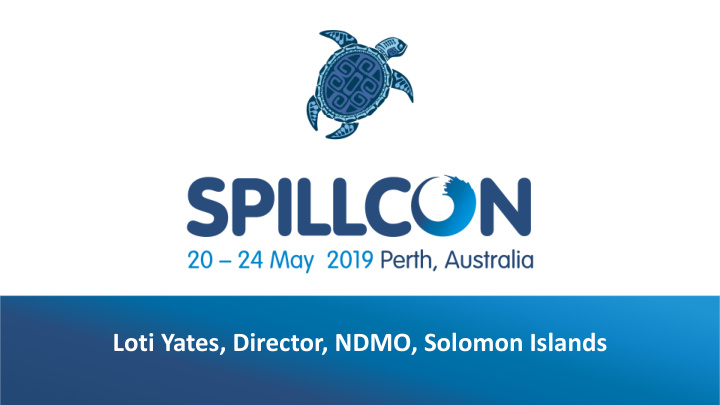



Loti Yates, Director, NDMO, Solomon Islands
THE GROUNDING OF THE SOLOMON TRADER
Weather watch & Warnings • Meteorological warnings issued due to presence of low depression in the region. • Strong Wind warning No.1 issued by Solomon Island Met Services at 4.30pm 3 rd Feb 2019. • Expect West to Southwest winds of 15 to 25 knots with moderate to rough seas and moderate swells (2.5 meters) over most waters in the next 24 to 48 hours. • Solomon Trader grounding 4 TH /5 th February 2019 around midnight (Vessel position 11-40.77S 160-18.8E) • All Crew evacuated from casualty 7 th February 2019 – No injuries/casualties • Weather depression upgraded to TC OMA and continued to delay response for another 7 days.
LOCATION OF CASUALTY (11-40.77S 160-18.8E) 4
Airport & Communication Solomon Trader SW’ly wind 5
Suddenly happened
PA PARTICULARS OF OF T THE C CASUALTY Type: Bulk Carrier, Self-Geared IMO No: 9075670 Registered: Hongkong Principal Dimension: - Length (LOA): 224.97 m - LBP: 217.00 m - Moulded Breadth: 32.28 m - Moulded Depth: 19.00 m Deadweight: 73,592 T Lightship: 10,642 T TPC: 69.08 t/cm 7
CARGO ON BOARD 10,850 MT of • 10,850 MT of Bauxite (pic) Bauxite
Timeline of events • Initial notification of grounding to SI MRCC -5 th February 2019 • Communication on Incident between MRCC/Police/Ship owners for the next 7 days • Hull & Machinery deployed to scene • PI Club Deployed • National Oil Spill Committee called its first meeting 13 th Feb 2019 • Verbal briefing for DFAT contact point – 13 th Feb 2019. • The National Disaster Management Office was directed by Govt to tale lead in the coordination of response.
Timeline of events • AMSA & LOC support Embedded into the NDMO. This provided the foundation for the response. • SIG UN Support for JEU to be deployed to support SIG scope and set in place plans for EDA • The Govt had 3 main Operational Objectives • Removal and safe treatment of all hydrocarbons from vessel • Environmental clean-up • Removal of the wreck • SIG “Stand by Assistant” sought from Australia & NZ – AMSA/NZMSA • AMSA/NZMSA personnel and assets deployed
THE RESPONSE/COORDINATION National Emergency Operation • Salvors – Resolve Marine Centre (Honiara) • Protection & Indemnity Club • SIMSA (Korean Protection Indemnity • Environment Dept Club) • Fisheries • ITOPF • Health • Mining Company – BMCSI • Police/Fire & Emergency (Charterers) • OSOCC – Onsite Operation • AMSA/NZMSA Coordination Center – Lavagu Rennell Island
Nationa nal Level Co Coordi dina nation n Arr rrang ngement for r Renne nnell Island nd Oil Spi pill Respo pons nse NDC International Pa N-DOC Chair Incident Support, Club, Commander Salvors NEOC On-site Coordination N-DOC Sector Committees Private Sector (Bintang (Education, Health, Mining, Ship Owner, Oil Spill National Spills Committee Livelihood, Infrastructure, & Wreckage Service Protection, Camp Providers) Management)
THE RESPONSE/COORDINATION • National Level • Regular coordination briefing with Salvors, AMSA/NZMSA • Regular briefing for SIG agencies • Daily situation updates • Weekly situation reports • Sharing of info on progress with Salvors • Weekly meeting with Salvors and Club • OSOCC • Daily briefings – SIG/Salvors/Club • Joint assessments • Issuance of daily situation updates from OSOCC
OPERATIONAL STATUS (CURRENT) SIG Objectives Successful refloating of • Removal and safe treatment of all casualty 11 th May 2019 hydrocarbons from vessel. • Oil contained and ready for removal • Environmental clean-up • On-going discussions with Club for removal and clean up work progressing • Removal of the wreck • Re-floating successful, preparation for removal from country progressing
Challenges For the Govt • Insufficient legal backing within its legislations to support compensation claims. • Untested National Oils Spills plan. • Leadership and activation processes • Understanding roles and responsibilities • Lack of Resources to deal with Oil Spill of this magnitude - funds, personnel with relevant expertise and equipment to deal
Challenges • Logistics • Remoteness – Site close to Honiara but lack infrastructure and access point from sea. • Airport – Short runway – twin otter aircraft only • Communication difficulties – No communication means at site of casualty. • Lack of accommodation • High Operational costs • Land Tenure System – Use of Local laborers for OSR especially clean up – lack of necessary skillsets for this type of work. • On-going mining and logging operations within the site of the casualty
Lessons Learnt for future contingency planning • Review of relevant Legislations – SIMSA, Environment, Mining etc • Regional/National Preparedness – Oil spill risks low compared to other global hotspots & with lack of infrastructure, best to share resources. Regional instruments and Secretariats should be harnessed better to provide the support - SPREP • Capacity/equipment – Most spills come ashore – cheaper to train laborers over accessing expensive equipment to contain oil whilst at sea. • Command & Control • Short turn around of staff managing the OSOCC • Communication difficulties and lack of presence of club in Honiara meant difficult to maintain operational understanding. • Insurers to ensure support to Govt to ensure
Lessons Learnt for future contingency planning • Preapproved waste facilities • Recycling of liquid oil • Incineration in power plants, cement plants and oil refineries • Use of stabilised sediment in road construction • Prearranged waste storage facilities • identify where hazardous material could be stored in the event of a spill and provide a map of these sites on a contingency plan.
Recommend
More recommend